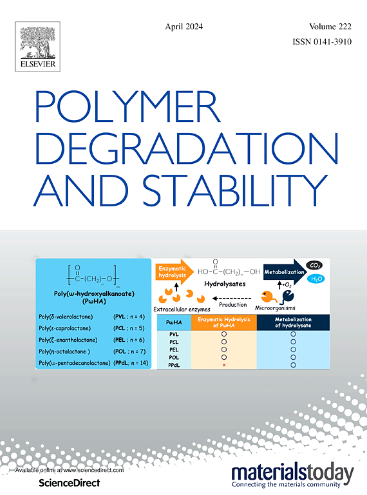利用溶胶-凝胶技术从渔业废料中制备含有功能化壳聚糖的新型无卤阻燃剂及其在聚氨酯树脂中的防火性能
IF 7.4
2区 化学
Q1 POLYMER SCIENCE
引用次数: 0
摘要
从虾蟹壳等渔业废弃物中提取的壳聚糖(CS)被用于制造一种生物基生态友好型阻燃剂。通过将壳聚糖的 -NH2 基团和多磷酸三聚氰胺(MPP)的 NH2 基团与多亚甲基多苯基多异氰酸酯(PMPI)的 NCO 基团反应,合成了一种新型膨胀型阻燃剂 CS-PMPI-MPP。异佛尔酮二异氰酸酯(IPDI)与多元醇和氨基丙基三乙氧基硅烷(APTS)反应生成含硅的聚氨酯(Si-PU),并在其中加入阻燃剂,通过溶胶-凝胶技术制成高聚物复合材料。分析了复合材料的结构、热性能、阻燃性、机械性能、毒性和成炭性。分析方法包括傅里叶变换红外光谱、热重分析、极限氧指数、锥形量热仪、UL-94、热重分析与红外光谱、万能试验机、扫描电子显微镜、X 射线光电子能谱、拉曼光谱和烟密度测试分析。热重测试结果表明,添加 CS-PMPI-MPP 后,原始聚氨酯的炭产量从 0.5 wt%增加到 25.9 wt%,这表明原始聚氨酯的热稳定性得到了提高。根据极限氧指数和 UL-94 数据,加入 CS-PMPI-MPP 后,极限氧指数和 UL-94 评级从 18.2% (Fail) 提高到 26.5% (V-1),这表明 CS-PMPI-MPP 在原始聚氨酯配方中具有优异的阻燃性能。本文章由计算机程序翻译,如有差异,请以英文原文为准。
Fabrication of novel halogen-free flame retardant containing functionalized chitosan from fisheries waste through the sol-gel technology and its fire safety performance in polyurethane resin
Chitosan (CS) derived from fisheries waste, such as shrimp and crab shells, was used to fabricate a bio-based, ecofriendly flame retardant. By reacting the –NH2 groups of CS and the NH2 groups of melamine polyphosphate (MPP) with the NCO groups of polymethylene polyphenyl polyisocyanate (PMPI), a novel intumescent flame retardant, CS-PMPI-MPP, was synthesized. Isophorone diisocyanate (IPDI) was reacted with polyol and aminopropyltriethoxysilane (APTS) to form a polyurethane containing silicon (Si-PU), into which the flame retardant was incorporated to produce a high-polymer composite through the sol-gel technology. The structure, thermal properties, flame retardancy, mechanical properties, toxicity, and char formation of the composites were analyzed. Fourier transform infrared spectroscopy, thermogravimetric analysis, limiting oxygen index, cone calorimeter, UL-94, thermogravimetric analysis with infrared spectroscopy, universal testing machine, scanning electron microscopy, X-ray photoelectron spectroscopy, raman spectroscopy, and smoke density test analyses were performed. The thermogravimetric test results indicated an increase in char yield from 0.5 wt% in pristine polyurethane to 25.9 wt% upon the addition of CS-PMPI-MPP, signifying an enhancement in the thermal stability of pristine polyurethane. According to limiting oxygen index and UL-94 data, the incorporation of CS-PMPI-MPP improved the limiting oxygen index and UL-94 ratings from 18.2 % (Fail) to 26.5 % (V-1), demonstrating the exceptional flame-retardant property of CS-PMPI-MPP within the pristine polyurethane formulation.
求助全文
通过发布文献求助,成功后即可免费获取论文全文。
去求助
来源期刊

Polymer Degradation and Stability
化学-高分子科学
CiteScore
10.10
自引率
10.20%
发文量
325
审稿时长
23 days
期刊介绍:
Polymer Degradation and Stability deals with the degradation reactions and their control which are a major preoccupation of practitioners of the many and diverse aspects of modern polymer technology.
Deteriorative reactions occur during processing, when polymers are subjected to heat, oxygen and mechanical stress, and during the useful life of the materials when oxygen and sunlight are the most important degradative agencies. In more specialised applications, degradation may be induced by high energy radiation, ozone, atmospheric pollutants, mechanical stress, biological action, hydrolysis and many other influences. The mechanisms of these reactions and stabilisation processes must be understood if the technology and application of polymers are to continue to advance. The reporting of investigations of this kind is therefore a major function of this journal.
However there are also new developments in polymer technology in which degradation processes find positive applications. For example, photodegradable plastics are now available, the recycling of polymeric products will become increasingly important, degradation and combustion studies are involved in the definition of the fire hazards which are associated with polymeric materials and the microelectronics industry is vitally dependent upon polymer degradation in the manufacture of its circuitry. Polymer properties may also be improved by processes like curing and grafting, the chemistry of which can be closely related to that which causes physical deterioration in other circumstances.
 求助内容:
求助内容: 应助结果提醒方式:
应助结果提醒方式:


